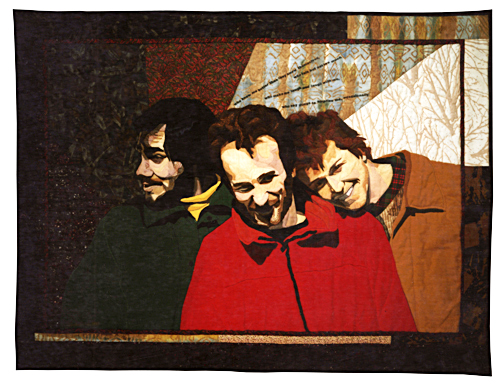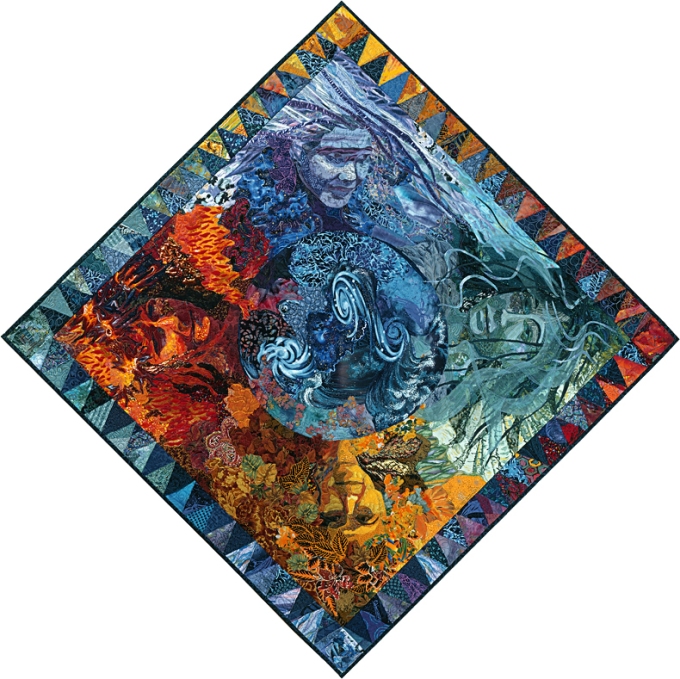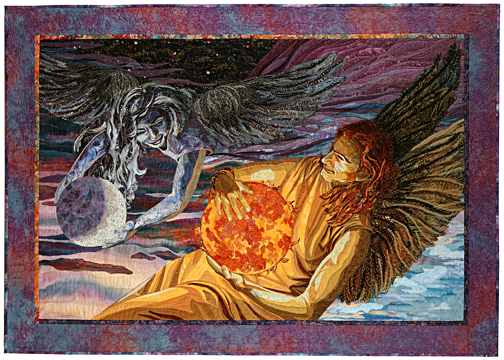From my husband Tom:
Okay! Change of plans. We were supposed to have a new post this week. Instead we’ll have one more week of my favorite posts while Susan completes the polar bear quilt between entertaining her German relatives.
Today’s featured quilt represents a milestone in Susan’s career. It marks a change both in her use of color and the development of her way of doing fabric collage. It was her first headfirst dive into non-realistic colors. She has never gone back since breaking out of that mindset. Also, this is the first quilt that is not shadow quilted through a layer of tulle to hold all the pieces in place. Instead each raw edge of fabric was glued securely, then quilted following those edges.
It’s a pleasure to me to be reminded of her development as an artist by reflecting on quilts such as “Elements.”
—Tom
Quilt Stories: “Elements”
Originally published June 8, 2019
I owned my fabric collage quilt “Elements” for such a brief time that it was lovely to visit with it when it was borrowed back from the owner to be included in my New England Quilt Museum show at the end of 2018. While I had access to it, I did a short “video tour” of the quilt, included below.
As I explain in its original Quilt Story (first posted in February 2016), “Elements” was a turning point for me and my career as an artist. A number of factors made this an important quilt: the use of non-literal colors, the unique design, and of course the encouragement I received from its warm reception.
Looking back, I see that the decision to use non-literal colors was a brave one. One thing that helped was that I made this quilt for myself. I didn’t make it as a commission for a client or even in order to sell it. In fact, the only reason it sold was that in order to be in the New Hampshire League of Craftsmen “Living with Crafts” exhibit it had to be for sale. So I put a high price on it that I thought would discourage all but the most avid collector. It was rather a bittersweet surprise when it did sell.
Perhaps because of the quilts they see in this blog, or due to my encouragement, many of my students nowadays come to class expecting to use non-realistic colors. They make blue wolves or orange big horn sheep or purple bears. They say, “I’m going to be brave and make my dog in greens!”
Personally, I think this is wonderful. I’m pleased to think that I’m contributing to a more vibrant world by encouraging my students to use color in a brave and exuberant way.
It all started with “Elements.”
Original Post

I seem to learn something from every quilt I make, like how to shape fabric around a curve (Golden Temple of the Good Girls) or how to hang a 22-foot long quilt (Crocodylus Smylus).
But some quilts are turning points. They mark a change in style, a way thinking, a way of seeing. “Elements” was such a turning point for me.
The quilt was inspired by a guild challenge: create a representation of the four elements—earth, air, water, and fire—in fabric. This was in 1993. Most of my quilts before that time had been portraits of people. I had just finished “Surprise Me,” a realistic portrait of my husband and his two college buddies. So of course I immediately thought of making a personification of each element.
But how to compose such a work?
I needed some sort of organizing structure to give me a starting point. I did some pencil sketches. I don’t remember other ideas I might have considered but not used. Eventually, I settled on a globe around which the four “earthly elements” would be arranged.
I don’t know why, but once I had the concept down it became clear that each element would be represented by a certain color. And then the circular format of course led to the idea of using the entire spectrum of color, one color blending to the next, like a huge color wheel.
Now all I needed were models for the portraits.
So I dug through my collection of snapshots. And yes, remember, this was 1993—they were snapshots. I was looking for nice closeups with appropriate expressions, and poses that I thought worked well in the composition. (Remember, 3/4 view is better than straight on.) As it turned out, though, I found that my choices also made sense of a sort according to the personalities of the models.

For Air, I chose a pic of my sister, Heidi. I liked the sweep of her hair and the angle of her head. Look how her eyes are focused ahead, as though bending into a gale. In her youth she was something of a free spirit, which seemed to suit the Air element.

For Water, I wanted long flowing locks as though they were floating free in the depths of the sea, like seaweed. And while the ocean can obviously be a ferocious place, I wanted to make my Water calm and peaceful. This picture of my friend Pam, who at that time had beautiful long hair, reflected the serenity and empathy she projects in real life and was something I tried to capture in her portrait.

Mother Earth may be a cliché, but the foundation of my life is my mama. So it seemed clear that she would be the personification of Earth. In this picture, her expression is ambiguous—a Mona Lisa expression—one that creates its own mystery. Is she smiling? I think so.

I needed someone for Fire, but none of the women in my pile of photos seemed quite right. Then of course it became obvious who was missing from the group. The one person tying all of them together. Myself. So maybe I wouldn’t have chosen Fire for myself, but the others worked so well, by process of elimination, it fell to me.
My mother thinks that I was a little harsh—that I could have made Fire more flattering. But Fire wasn’t intended to be a perfect likeness. I needed Fire to be harsher, more consuming than I feel I am.
Turning Points
Look at the following three quilts:



Notice any difference between “Surprise Me” and “Twilight”?
Yeah. Color. Lots of it.
The concept of personifying the elements gave me permission to use non-realistic colors. I’ve never required permission since then. I don’t think I have ever used “realistic” colors since then either, except in a few commissions.
I believe “Elements” would have been a turning point in my career no matter what, but it certainly helped that it received a very warm reception. That year I entered the quilt in the League of New Hampshire Craftsmen’s Annual Fair. It won the Best in Show at the Living With Crafts exhibit. Shortly after that I appeared on New Hampshire public television’s program “Crossroads.”
I think it’s an accepted fact, whether true or not, that an artist ought to pursue his or her craft without regard for recognition. The writer in his lonely garret. The painter selling his canvasses on street corners. The singer-songwriter strumming in the subway. We expect them to be satisfied with the coins we toss into their hats. We assume that artists don’t need recognition at all if they are really, truly dedicated to their art.
I’m not sure I believe that. After all, other than “More is better,” my husband says my motto is:
“All art is good art.”
I try to respond to art that way, to meet it where it stands rather than forcing it to meet my expectations of it.
I see beginning artists in every one of my classes. I don’t expect them to progress without an encouraging word. Why would I expect that of anyone else? Why would I expect that of myself?
Would I have continued to make quilts even if “Elements” hadn’t received so much positive attention? Probably. Eventually. Instead, the response it received accelerated my commitment to being an artist.
Who knows where I would be today if not for “Elements.”
Facial Features eWorkshop
Click here for more information.
- Eight videos (over 8 hours combined length) collected into one convenient and organized spot
- Each annotated with “Jump Points” allowing you to scan forward and backward to the information you need
- Facial Features Templates included as PDF’s to download and work along with
- Like the Fabric Collage Online Master Class, membership in this eWorkshop is for life
$99
BUY NOW
(With a special Summertime offer good from now through August 31st, 2023)






Susan is a quilt Goddess. I’ve never seen anything like this in all my years of admiring quilts. I’m just a humble beginner quilter. I’m hopeful one day when life slows down some I can spend my days “cutting loose.”
So happy to see this. It was great encouragement to use unusual colors, one of my favorite things in Susan’s works.